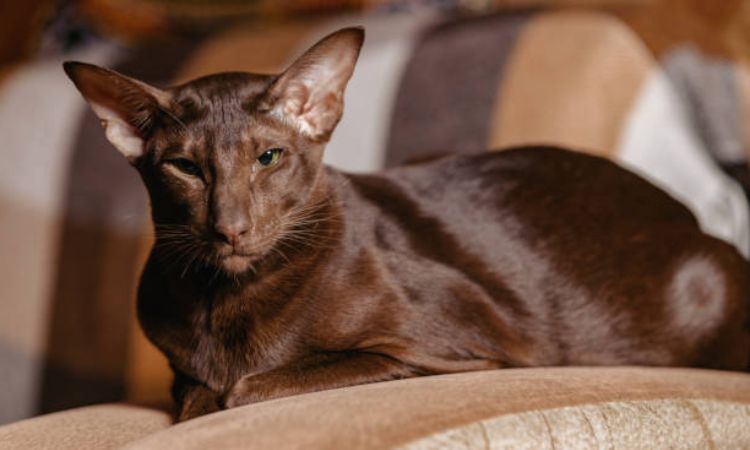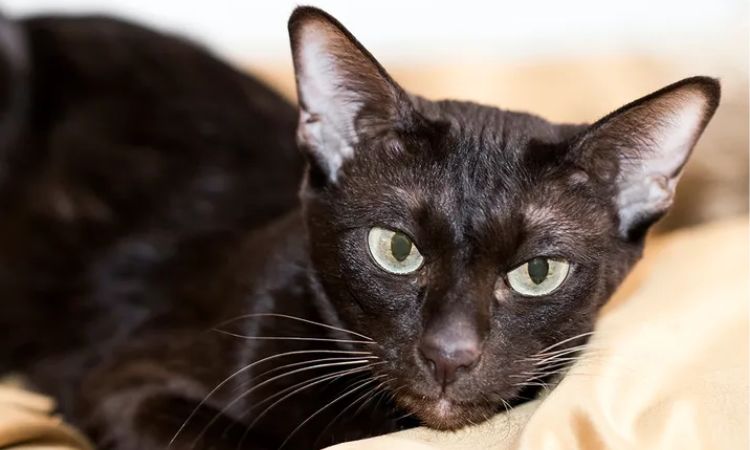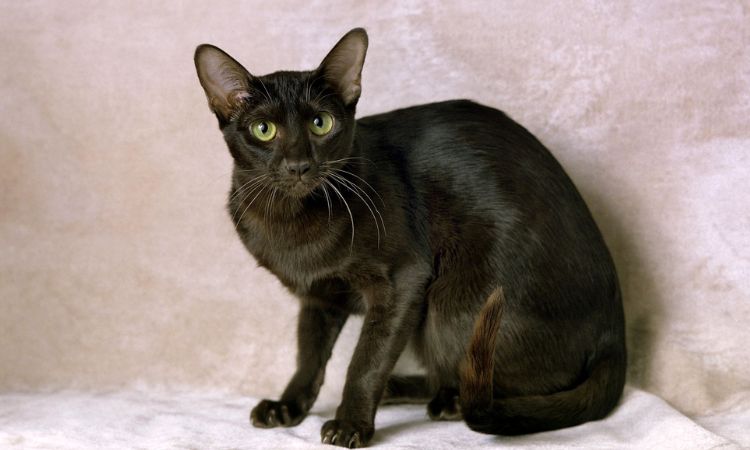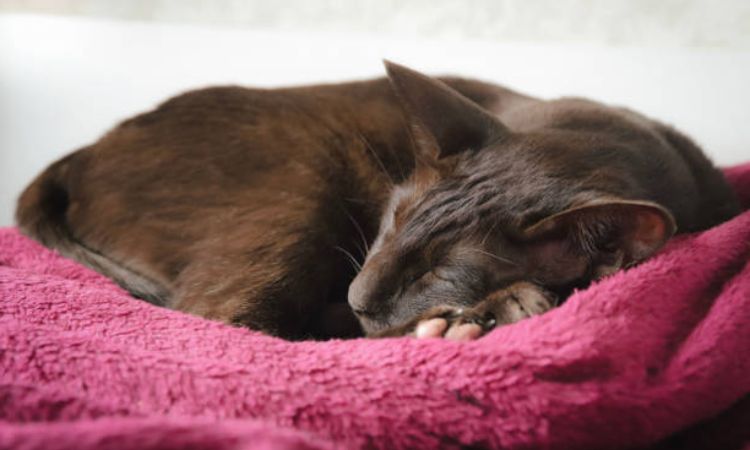The Havana Brown didn’t appear by accident—it was thoughtfully crafted by devoted English cat enthusiasts in the 1950s who dreamed of a sleek, cocoa-colored feline with charm to match its looks. Starting with Siamese and black domestic shorthairs, and later refined with Russian Blue influence, they shaped a breed unlike any other.
Curious about how this rare beauty came to be and what makes it such a captivating companion? Let’s explore the Havana Brown’s history, personality, health, and what to expect as an owner.

History and Origin of the Havana Brown
Early Development in England
The Havana Brown’s story begins in late 19th-century Europe, where solid brown cats with Siamese features occasionally appeared in cat shows. These chestnut-colored felines—sometimes referred to as Swiss Mountain Cats—were shown alongside Siamese but quietly faded from the scene by the 1920s, when only blue-eyed, pointed Siamese were considered desirable in Britain.
After World War II, interest in producing a self-brown cat returned. In the early 1950s, a group of dedicated English breeders formed what became known as “The Havana Group” (later “The Chestnut Brown Group”). Their goal was to create a rich brown cat with a refined, foreign type. To do this, they deliberately crossed chocolate gene–carrying Siamese with black domestic shorthair cats also carrying the chocolate gene. Some early breeders experimented with Russian Blue of Oriental Siamese type, though modern DNA evidence indicates that little of that influence remains today.
Their pioneering efforts produced the foundation of the modern Havana Brown. One of the first documented cats from this program was Elmtower Bronze Idol, registered in 1952 and often cited as the breed’s earliest official representative.
Development in the United States
Two kittens from the English program were exported to the United States, where the breed began to take shape in a slightly different direction. American breeders focused on preserving the moderate conformation, deep brown coat, and distinctive muzzle seen in the original lines. Rather than introducing extensive outcrosses, they primarily bred their imports with chocolate and seal point Siamese to establish a strong and consistent gene pool.
This careful work produced a cat with a warm, mahogany coat and a unique, rounded head shape—traits that now define the American-type Havana Brown. The Cat Fanciers’ Association (CFA) recognized the breed for registration in 1959 and granted it Championship status in 1964, cementing its place among pedigreed cats in North America.
Name Origin: “Havana”
The Havana Brown did not originate in Havana, Cuba. Instead, its name is believed to be inspired by its luxurious coat color. Two popular theories explain the naming:
- Havana cigar connection: Many fanciers associate the cat’s rich brown coat with the deep, reddish-brown shade of Havana cigars or tobacco.
- Havana rabbit theory: Others believe the name refers to the Havana rabbit, a breed known for its similar chocolate-brown fur.
Regardless of which origin is correct, both explanations tie the name to color rather than geography.
Key Physical Traits and Appearance

1. Coat and Color
The Havana Brown is instantly recognizable for its rich, warm mahogany coat, a uniform reddish-brown color that extends from the tips of its ears to the tip of its tail. The coat is short, smooth, and glossy, giving the cat an elegant and polished appearance. A unique hallmark of the breed is its brown whiskers and nose leather, which perfectly match the coat. While kittens may exhibit faint “ghost” tabby markings, these typically fade completely by adulthood, leaving a solid, even color.
2. Body Structure
Havana Browns are medium-sized cats with a well-balanced, muscular, yet graceful build. Their bodies are moderately long, neither too compact nor overly elongated, providing agility and elegance in movement. Adult cats typically weigh between 6 and 10 pounds, with males usually slightly larger than females. Sterilized individuals may sometimes appear a bit heavier, but the breed maintains a natural, athletic form.
3. Head and Face
The head of a Havana Brown is slightly longer than wide, giving it a gentle wedge-like appearance without extremes. Its distinctive muzzle and pronounced whisker pads create a subtly rounded, expressive look, often described as “corncob” or “rolled cigar” shaped. From the side, the nose shows a clear break or stop, adding to the breed’s unique profile. The ears are large, broad at the base, set apart, and tilt slightly forward, giving the cat an alert and curious expression.
4. Eye Color
One of the Havana Brown’s most striking features is its large, oval-shaped green eyes, which contrast beautifully against the chocolate-brown coat. The eyes are set wide apart and are vividly colored, ranging from bright emerald to deep forest green, making them a signature trait of the breed.
Personality and Temperament
1. Affectionate and People-Oriented
Havana Browns are deeply affectionate cats that thrive on human companionship. They often develop a strong bond with a primary person, following them around the house and staying close throughout the day. Owners describe their behavior as “puppy-like”, due to their loyal and interactive nature.
- They frequently pat their owners with their paws, a gentle and endearing way of asking for attention or communication.
- This breed does not do well when left alone for long periods, so they are best suited for families where someone is home most of the time or with another companion pet.
- They enjoy being physically close, curling up on laps, sitting near you while you work, or even riding on shoulders.
2. Intelligence and Curiosity
Havana Browns are highly intelligent and inquisitive cats, constantly exploring their surroundings and engaging with new stimuli.
- They use their paws to investigate objects, test textures, and manipulate toys, showing both curiosity and problem-solving ability.
- They excel at interactive play—puzzle feeders, treat-dispensing toys, and games that challenge their mind are perfect for this breed.
- Many Havana Browns can learn tricks, such as fetching small toys or responding to commands, thanks to their high learning capacity.
3. Sociability
This breed is exceptionally sociable, enjoying interactions with humans and other pets alike.
- They are friendly toward strangers, often greeting visitors with curiosity rather than fear.
- Havana Browns usually coexist well with children, other cats, and even dogs if introductions are handled properly.
- They thrive in households where they are included in daily family routines and enjoy being part of the household activity rather than sitting alone.
4. Vocalization
Havana Browns are moderately talkative.
- Their voice is soft, gentle, and sweet, unlike the louder Siamese meows.
- They communicate curiosity, excitement, or requests for attention in a subtle and endearing way, often using chirps, soft mews, and occasional purring.
5. Activity Level
Havana Browns maintain a playful and energetic personality well into adulthood.
- They are moderately active, enjoying both vigorous play and calm relaxation.
- Activities they love include climbing, chasing toys, playing fetch, or exploring their environment.
- Despite their playful energy, they equally enjoy lounging on a favorite chair, lap, or cozy spot near their human companion.

Health and Wellness
Havana Browns are not just strikingly beautiful—they’re curious, affectionate, and full of personality. Keeping your Havana Brown healthy means understanding both general cat care and breed-specific needs.
Weight and Nutrition
- Maintaining a healthy weight is essential. Overweight cats face higher risks of diabetes, arthritis, and liver problems. Feed measured portions of high-quality food, offer fresh water, and engage your cat with interactive toys or food puzzles to keep her active.
Dental Care
- Dental hygiene is often overlooked. Regular tooth brushing prevents tartar buildup, gum infections, and tooth loss. Schedule routine dental check-ups for preventive care.
Vaccinations & Parasite Control
- Havana Browns need core vaccines to protect against panleukopenia, calicivirus, and rabies. Prevent fleas, ticks, and intestinal worms through regular check-ups and preventive treatments.
Spaying & Neutering
- Spaying or neutering helps prevent cancers, unwanted litters, and territorial behaviors. It’s also an opportunity for a full health check under anesthesia.
Breed-Specific Health Risks
- Heart Disease: Hypertrophic cardiomyopathy (HCM) may develop; routine exams help early detection.
- Urinary Issues (FLUTD): Watch for signs of painful urination or accidents outside the litter box.
- Kidney Disease & Diabetes: Regular check-ups and proper diet reduce risks.
- Allergies/Atopy: Itchy skin, hair loss, or ear infections may indicate allergies.
At-Home Care Tips
- Brush their short coat weekly and check ears regularly.
- Maintain dental care at least twice a week.
- Keep them indoors and provide stimulating play for physical and mental exercise.
- Monitor behavior, appetite, and litter box habits to catch problems early.
Seek immediate care if you notice difficulty urinating, sudden weakness, abnormal bleeding, or eye/ear issues.
Ownership and Care Guide

1. Grooming Needs
- Coat: The Havana Brown has a short, silky, mahogany coat that is naturally low-maintenance. Weekly brushing with a soft or rubber brush is sufficient to remove loose hair, maintain shine, and prevent minor tangles. Shedding is minimal, making this breed easy to groom.
- Oral Hygiene: Dental care is essential. Brush your cat’s teeth daily or at least 2–3 times per week to prevent tartar buildup, gingivitis, and other oral diseases. Regular dental check-ups with your veterinarian are also recommended.
- Nails & Ears: Trim nails regularly to prevent overgrowth or scratching injuries. Check ears weekly for wax, debris, or signs of infection and clean them gently when necessary.
2. Diet and Nutrition
- Food: Havana Browns require a high-quality, protein-rich diet, which can include wet, dry, or mixed food formulated for adult cats. Look for diets rich in essential fatty acids to maintain a healthy coat and skin.
- Portion Control: Overfeeding can lead to obesity, which increases the risk of diabetes, arthritis, and other health problems. Follow recommended feeding guidelines and monitor your cat’s weight.
- Water: Provide constant access to fresh, clean water. Many Havana Browns enjoy drinking from fountains, which encourages hydration and supports urinary tract health.
3. Exercise and Enrichment
- Physical Activity: Havana Browns are lively and curious. They need daily play sessions to maintain physical health and prevent boredom. Activities like fetch, chasing feather wands, or laser pointers are highly recommended.
- Mental Stimulation: Puzzle toys, treat-dispensing games, and interactive activities help satisfy their intelligence and inquisitive nature.
- Vertical Spaces: Provide cat trees, shelves, or climbing furniture. Vertical exploration supports exercise, reduces stress, and satisfies their natural curiosity.
4. Ideal Home Environment
- Living Space: This breed adapts well to apartments or houses, as long as they receive attention and mental stimulation.
- Social Needs: Havana Browns are highly people-oriented and may develop separation anxiety if left alone for long periods. Consider having a second pet or providing engaging toys to prevent loneliness.
- Indoor Environment: They thrive indoors in a safe, enriched environment with scratching posts, climbing spaces, and interactive toys, along with loving human interaction. They are sensitive to temperature and should be kept indoors for safety and comfort.
5. Health Considerations (Essential for Owners)
- Weight Management: Monitor body condition to prevent obesity-related illnesses like diabetes, hepatic lipidosis, and arthritis. Encourage activity and regulate food intake.
- Dental Health: Prevent dental disease with brushing, check-ups, and routine cleanings.
- Vaccinations: Core vaccines include panleukopenia, calicivirus, rhinotracheitis, and rabies; additional vaccines based on lifestyle may include FeLV.
- Parasite Control: Protect against fleas, ticks, worms, and other parasites through regular testing and preventive medications.
- Spay/Neuter: Reduces cancer risk, territorial behavior, and unwanted litters. Also allows concurrent health checks under anesthesia.
- Genetic Predispositions:
- Heart disease (hypertrophic cardiomyopathy)
- FLUTD (urinary issues)
- Kidney disease and renal failure
- Hyperthyroidism
- Diabetes mellitus
- Allergies/atopy
- Rare blood disorders (hemophilia)
6. Daily & Weekly Routine
| Task | Frequency |
| Coat brushing | Weekly |
| Dental care | 2–3 times per week |
| Nail trimming | As needed |
| Ear check/cleaning | Weekly |
| Interactive play | Daily (20–30 minutes) |
| Monitor appetite, weight, water intake | Daily |
| Vet wellness exams | Every 6 months |
| Vaccination / parasite prevention | As recommended |
Havana Browns are rare, affectionate, intelligent, and playful. They are low-maintenance in terms of grooming but require balanced nutrition, regular exercise, mental stimulation, and close human interaction. With proper care, these cats can thrive for 10–15 years, bringing companionship, charm, and curiosity into their owner’s life.






